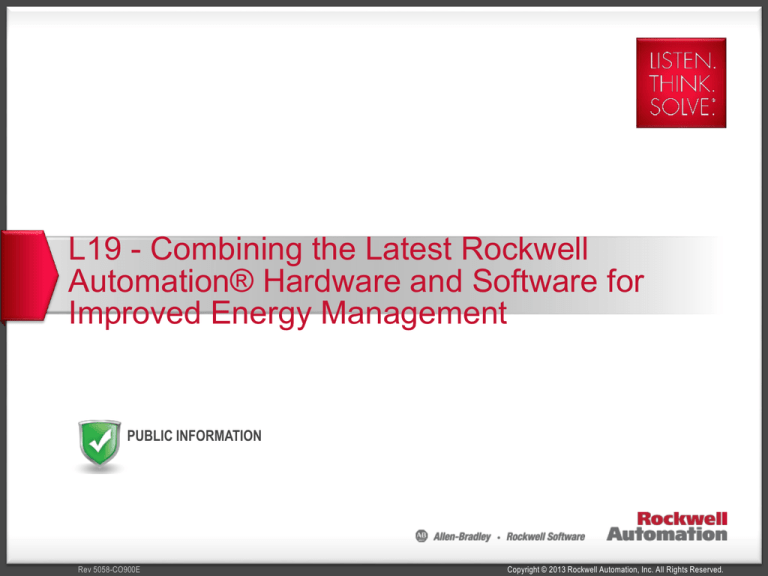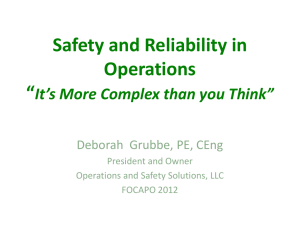
L19 - Combining the Latest Rockwell
Automation® Hardware and Software for
Improved Energy Management
PUBLIC INFORMATION
Rev 5058-CO900E
Copyright © 2013 Rockwell Automation, Inc. All Rights Reserved.
Sustainable Production Inputs
Add this flow to next slide
Materials / parts
Materials / parts
Information
Energy
Materials
Information
Energy is a great place to start
PUBLIC INFORMATION
Copyright © 2013 Rockwell Automation, Inc. All Rights Reserved.
2
Why Manage Industrial Energy?
The Industrial sector consumes more
energy than any other.
Total Energy Consumption
by Sector
Top Market Pressures
Source: US Energy Information Agency:
Aberdeen Group Report 2011
Rockwell Automation is an Industry Leader in helping customers
optimize their production operations to reduce cost
PUBLIC INFORMATION
Copyright © 2013 Rockwell Automation, Inc. All Rights Reserved.
What is the difference?
For the sake of this discussion:
Power/Energy Management:
Providing solutions that enable a customer to optimize the
consumption and demand of energy in their plant or at a specific
process.
Power Quality Management:
Providing solutions that minimize the impact of both external and
internal power quality events/conditions that can impact the uptime or performance of a plant or a specific process.
Both solutions have similar aspects or parts:
Power Monitoring, Data organization or analysis through a tool or
software, *System optimization
PUBLIC INFORMATION
*Very different remediation solutions (Solving a different problem)
Copyright © 2013 Rockwell Automation, Inc. All Rights Reserved.
4
Power Management (Direct cost)
Consumption
Real, Reactive, and Apparent Energy
Demand
Real, Reactive, and Apparent Power
Time interval determined by utility
Time of day matters
Ratchet Penalties
Power Factor
Lagging (penalty for reactive energy draw)
Leading (giving away energy to utility)
PUBLIC INFORMATION
Copyright © 2013 Rockwell Automation, Inc. All Rights Reserved.
5
Power Quality
Harmonics
Voltage
Sag/Swell
PUBLIC INFORMATION
Transient
Detection
Copyright © 2013 Rockwell Automation, Inc. All Rights Reserved.
Energy Usage vs. Production
Energy usage is traditionally metered to the Factory wall as part of facilities infrastructure
Limitations:
Difficult to correlate energy consumption with real-time production information
Difficult to compare energy used during different batches
Difficult to compare energy costs for a particular product run
What is happening within a manufacturing facility ‘with’ the energy resources being consumed is
typically a ‘black’ box
What am I actually making with all of these resources?
How much electricity was used during this production run?
How is the power quality?
How much energy is consumed during peak?
‘Measured to the Building’
PUBLIC INFORMATION
Copyright © 2013 Rockwell Automation, Inc. All Rights Reserved.
7
Energy Usage vs. Production
Identify large or critical loads
Install Powermonitors where needed
Implement monitoring software
Drive accountability
Monitor results
Utility Feeds 138 kV
Powermonitor 3000 M6
West
East
Allen-Bradley
Powermonitor 3000
L1
25.04M
WATT
Utility meter
kWh
Switchgear 12,470 V
Powermonitor 1000
Typical for 5
RS-485
EtherNet/IP
RS-485
RX
ACT
LNK
+
-
TX
STATUS
Boiler house
Substation
Mod Net
SHLD
Shipping / Receiving
Substation
Production
Substation #1
Power house
Substation
4160 V
Powermonitor 1000
Production
Substation #2
480 V
RS-485
EtherNet/IP
RS-485
RX
ACT
LNK
+
-
TX
STATUS
Powermonitor 1000
RS-485
EtherNet/IP
Mod Net
RS-485
RX
480 V
SHLD
ACT
LNK
+
-
TX
STATUS
RS-485
RX
RS-485
STATUS
480 V
RX
ACT
MCC 4
RS-485
EtherNet/IP
RS-485
EtherNet/IP
LNK
+
-
TX
Powermonitor 1000
ACT
Mod Net
LNK
+
TX
STATUS
Powermonitor 1000
Mod Net
480 V
-
SHLD
SHLD
Powermonitor 1000
Mod Net
SHLD
MCC 5
MCC 6
MCC 3
MCC 1
‘Measured to the Production Line’
PUBLIC INFORMATION
MCC 7
MCC 9
Data
center
UPS
MCC 2
MCC 8
EtherNet/IP
R
S
-
4
8
RS-485
5
RX
ACT
LNK
+
-
TX
STATUS
Powermonitor 1000
Mod Net
SHLD
Copyright © 2013 Rockwell Automation, Inc. All Rights Reserved.
8
Understanding Energy
Reduce Consumption
Power-down equipment when not in use
Install more energy-efficient equipment
Repair/Replace broken equipment
Reduce Demand
Stagger startups
Perform startups during off-peak hours
Reduce frequency of startups
Correct Power Factor
Install capacitor banks to balance load
Reduce operation of inductive loads
Reduce Downtime
PUBLIC INFORMATION
Optimize preventative maintenance
Diagnose power quality issues impacting equipment health and grid stability
Copyright © 2013 Rockwell Automation, Inc. All Rights Reserved.
9
Thank you!!
PUBLIC INFORMATION
Follow ROKAutomation on Facebook & Twitter.
Connect with us on LinkedIn.
www.rockwellautomation.com
Rev 5058-CO900E
Copyright © 2013 Rockwell Automation, Inc. All Rights Reserved.


